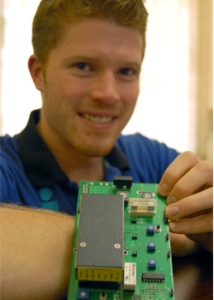Sep 6 2013
Physicists from the University of the Witwatersrand in Johannesburg have reached an important milestone and have made the first South African contribution of a “piece of hardware” to the ATLAS Experiment on the Large Hadron Collider (LHC) at the European Organization of Nuclear Research (CERN).
 Robert Reed holding the HV board he developed.
Robert Reed holding the HV board he developed.
Physics PhD student Robert Reed designed a High Voltage board (HV board) that was delivered to the ATLAS team in Geneva, Switzerland. The HV board was successfully integrated into the ATLAS system on Monday, 2 September 2013.
Professor Bruce Mellado from the newly established High Energy Physics Group in the School of Physics at Wits said manufacturing the HV board is “a proof of principle that we in South Africa can deliver with similar standards as our European counterparts. It is also not only an academic exercise, but a real product that will be used for real detector maintenance of the ATLAS detector.” Mellado joined Wits last year having played a leading role in the discovery of the Higgs boson particle with the ATLAS detector.
The LHC shut down in February this year for a two-year maintenance and upgrade programme to boost the level of energy that it uses to smash protons together. It will be back online in 2015. In the meantime, new and upgraded technologies are being developed to assist with the high-level maintenance.
The HV board is located inside the Mobile Drawer Integrity Checking (MobiDICK) system – a mobile version of the test bench which was used during the electronics production at CERN. The HV board is used to produce high voltage to the Photo Multiplier Tubes (PMTs) which are used in the simulation of data taking in order to test the front end electronics of the detector.
The HV board that Reed has designed are used in new mobile testing equipment – a mobile drawer integrity checking system - and its main function is to produce high voltage accurately and reliably. The head technician of the School of Physics, Charles Sandrock coordinated the delivery of electronics components and the production of the board by the local South African electronics industry.
"On the ATLAS detector you have these drawers of electronics that do all the filtering of the raw data that comes out of the detector. These electronics have to be verified and checked before the LHC starts-up in 2015. The new mobile testing equipment basically is a mobile box which the detector maintenance people will use to connect to the detector which would run the test on this drawer of electronics,” Reed explained.
Reed and the High Energy Physics Group will be producing a total of six HV boards for the mobile testing equipment that will be used to test the detector before ATLAS is deployed again for a high energy run.
Reed wrote a paper on his design, titled A Revised High Voltage Board for the Consolidation of Front End Electronics on the Tile Calorimeter of the ATLAS Detector, for which he won the PhD Poster: First Prize at the South African Institute of Physics Conference in July and the PhD Poster: Second Prize at the 5th Cross Faculty Graduate Symposium at Wits.